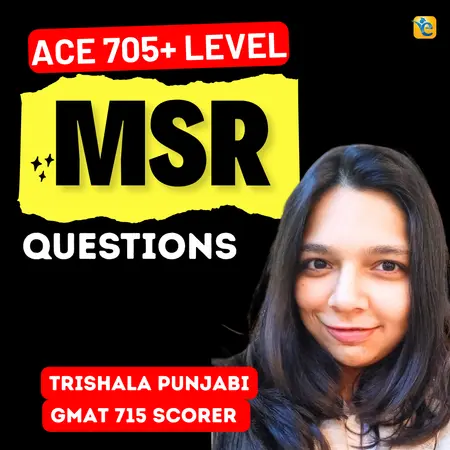Events & Promotions
|
|

GMAT Club Daily Prep
Thank you for using the timer - this advanced tool can estimate your performance and suggest more practice questions. We have subscribed you to Daily Prep Questions via email.
Customized
for You
Track
Your Progress
Practice
Pays
Not interested in getting valuable practice questions and articles delivered to your email? No problem, unsubscribe here.
- Nov 18
11:00 AM PST
-12:00 PM PST
Join us in a live GMAT practice session and solve 30 challenging GMAT questions with other test takers in timed conditions, covering GMAT Quant, Data Sufficiency, Data Insights, Reading Comprehension, and Critical Reasoning questions. - Nov 22
11:00 AM IST
-01:00 PM IST
Do RC/MSR passages scare you? e-GMAT is conducting a masterclass to help you learn – Learn effective reading strategies Tackle difficult RC & MSR with confidence Excel in timed test environment - Nov 23
11:00 AM IST
-01:00 PM IST
Attend this free GMAT Algebra Webinar and learn how to master the most challenging Inequalities and Absolute Value problems with ease. - Nov 25
10:00 AM EST
-11:00 AM EST
Prefer video-based learning? The Target Test Prep OnDemand course is a one-of-a-kind video masterclass featuring 400 hours of lecture-style teaching by Scott Woodbury-Stewart, founder of Target Test Prep and one of the most accomplished GMAT instructors.
C
Be sure to select an answer first to save it in the Error Log before revealing the correct answer (OA)!
Difficulty:
 25%
(medium)
25%
(medium)
Question Stats:
79% (01:43) correct 21%
(02:10)
wrong
21%
(02:10)
wrong  based on 6524
sessions
based on 6524
sessions
History
Date
Time
Result
Not Attempted Yet
If the airspace around centrally located airports were restricted to commercial airliners and only those private planes equipped with radar, most of the private-plane traffic would be forced to use outlying airfields. Such a reduction in the amount of private-plane traffic would reduce the risk of midair collision around the centrally located airports
The conclusion drawn in the first sentence depends on which of the following assumptions?
(A) Outlying airfields would be as convenient as centrally located airports for most pilots of private planes.
(B) Most outlying airfields are not equipped to handle commercial-airline traffic.
(C) Most private planes that use centrally located airports are not equipped with radar.
(D) Commercial airliners are at greater risk of becoming involved in midair collisions than are private planes.
(E) A reduction in the risk of midair collision would eventually lead to increases in commercial airline traffic.
Same stem different question is HERE.
The conclusion drawn in the first sentence depends on which of the following assumptions?
(A) Outlying airfields would be as convenient as centrally located airports for most pilots of private planes.
(B) Most outlying airfields are not equipped to handle commercial-airline traffic.
(C) Most private planes that use centrally located airports are not equipped with radar.
(D) Commercial airliners are at greater risk of becoming involved in midair collisions than are private planes.
(E) A reduction in the risk of midair collision would eventually lead to increases in commercial airline traffic.
Same stem different question is HERE.
Kudos
Bookmarks
I have picked C for this question:
The conclusion is: [highlight]The risk of midair collisions are the centrally located airports would be reduced.[/highlight]
A. This does not make sense. The reason for moving many of the private planes to the outlying airfields is not because of the convenience for the pilots.
B. Whether the outlying airfields can handle commercial airline traffic is irrelevant.
C. This is the correct answer. The passage states that "centrally located airports were restricted to commercial airliners and only those private planes equipped with radar." Therefore, the type of plane that cannot use the centrally located airports are the private planes that do not have radar.
D. This is not the assumed reason for moving private airplanes to outlying airfields.
E. How does the passage even prove this? This cannot be assumed.
The conclusion is: [highlight]The risk of midair collisions are the centrally located airports would be reduced.[/highlight]
A. This does not make sense. The reason for moving many of the private planes to the outlying airfields is not because of the convenience for the pilots.
B. Whether the outlying airfields can handle commercial airline traffic is irrelevant.
C. This is the correct answer. The passage states that "centrally located airports were restricted to commercial airliners and only those private planes equipped with radar." Therefore, the type of plane that cannot use the centrally located airports are the private planes that do not have radar.
D. This is not the assumed reason for moving private airplanes to outlying airfields.
E. How does the passage even prove this? This cannot be assumed.
Vercules
Expert
Joined: 23 Dec 2010
Last visit: 07 Aug 2019
Posts: 440
Given Kudos: 82
Status:Making every effort to create original content for you!!
Location: United States
Concentration: Healthcare, Social Entrepreneurship
Schools: Kenan-Flagler '15 (A) McCombs '15 (I) Tepper '15 (M) Kellogg '15 (I) HBS '15 (D) Wharton '15 (D) Stern '15 (WL) Simon '15 (A)
GMAT 1: 660 Q48 V34

GMAT 2: 750 Q49 V42

Expert reply
Schools: Kenan-Flagler '15 (A) McCombs '15 (I) Tepper '15 (M) Kellogg '15 (I) HBS '15 (D) Wharton '15 (D) Stern '15 (WL) Simon '15 (A)
GMAT 2: 750 Q49 V42

Posts: 440
Kudos
Bookmarks
imhimanshu
Hi Himanshu,
Good question.
The question stem says that the conclusion in the first sentence. If we analyze the structure of the sentence, then we will see that the stimulus contains two opinions
i) most of the private-plane traffic would be forced to use outlying airfields.
ii) Such a reduction in the amount of private-plane traffic would reduce the risk of midair collision around the centrally located airports.
The overall structure goes like this: First part of the fist sentence is the premise for i) and i) is used as a premise for the main conclusion ii).
i) is the intermediate conclusion, which the questions stem talks about.
We have to find an assumption that the author has to make to make his claim valid. Our assumption should validate that "most of the private-plane traffic would be forced to use outlying airfields"
First sentence says "only those private equipped with radar", so, the commercial planes not equipped with radar would not be able to use the airspace around the centrally located airport. Now, if most planes do not have a radar then they will be forced to use outlaying fields, reducing the overall traffic. Answer choice (C) does is very well, others could be true, but not necessarily validate the conclusion.
Hope that helps,
Vercules










